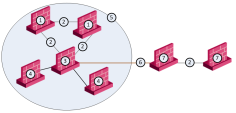BGP Route Reflection
By default, all BGP peers in an Autonomous System (AS) are in a full mesh.
However, if an AS has many BGP peers, the BGP configuration and hardware deployment is not easy.
To simplify configuration and deployment and avoid having to connect the peers in a full mesh, it is possible to configure:
-
One BGP peer as a route reflector.
-
All or some of the other BGP peers as clients of the route reflector.
The route reflector and its clients are known as a route reflection cluster![]() Two or more Security Gateways that work together in a redundant configuration - High Availability, or Load Sharing..
Two or more Security Gateways that work together in a redundant configuration - High Availability, or Load Sharing..
The route reflector sends the routes received from its peers to its clients.
In the example network below:
-
AS1 has five Check Point routers with enabled BGP.
-
One of the routers is a route reflector for two clients.
|
Item |
Description |
|
Item |
Description |
|---|---|---|---|---|
|
1 |
Non-clients |
|
5 |
AS1 |
|
2 |
iBGP |
|
6 |
eBGP |
|
3 |
Route Reflector in cluster |
|
7 |
AS676 |
|
4 |
Clients in cluster |
|
|
|
It is possible to define more than one route reflector in the AS to avoid having a single point of failure.
|
|
Best Practice - We recommend that you not use multiple redundant reflectors unnecessarily because it increases the memory required to keep routes on the peers of redundant reflectors. |
To learn more about route reflection, see RFC 2796.


